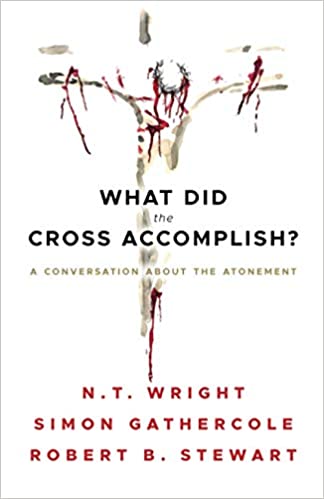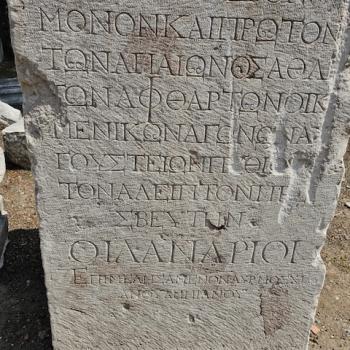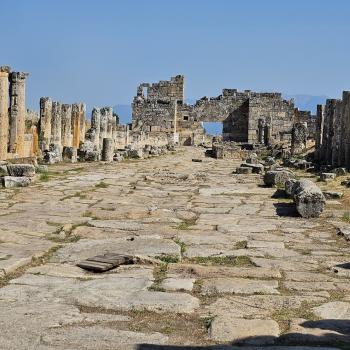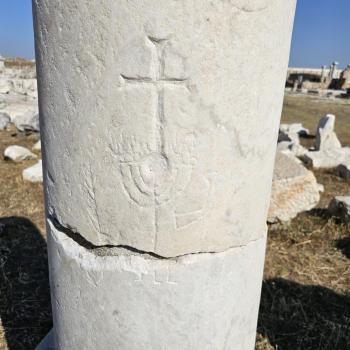This slender volume records the dialogue and Q and A that took place at the last Greer-Heard Forum at New Orleans Baptist Seminary, and includes a helpful introduction by Bob Stewart of that faculty on worldview and its importance. There were some other interesting papers by Doug Moo, Edith Humphrey, Kevin Vanhoozer and others which unfortunately Westminster-John Knox Press didn’t see fit to include in this volume, and that was a considerable mistake. What one mostly has is Tom Wright’s take on the issue of atonement, and to a considerably lesser degree the take of Simon Gathercole. Because of the sheer disproportion in the discussion, it becomes rather like a horse and rabbit stew, and you can guess which one most flavored the gumbo. Still, there are some interesting and helpful elements in this little volume, though if you are looking for a good extended discussion on atonement read Bill Craig’s book, and the Q+A that volumed on this blog in March and April.
One of the first points that Tom makes is that the term atonement is not self-explanatory, but rather is like a suitcase into which are packed a variety of ideas. I agree with this, and it’s one of the reason for the confusion about what the term actually refers to. On p. 26 Tom lists the Christus Victor (over the powers) theme, the notion of substitution, the idea of Jesus as the representative of his people, and the notion of Jesus as a moral example of self-sacrificial love. What is missing in this is the notion of Jesus bearing the punishment for our sins. On p. 29, Wright says boldly “Here I have changed my mind from all my previous expositions of this passage. Romans 3,24-26 is not speaking about the way sins are propitiated. The hilasterion is the lid of the ark, the place where the covenant God meets in grace with his people.” Frankly, this statement is not correct in what it denies and is only partially right in what it affirms. Any careful study of the hilaster- root and it’s cognates will show that propitiation is involved. Yes, the noun refers to the mercy seat, but not in the abstract. Indeed the very reason it is called the mercy seat is because it is where the atoning blood is applied, not least because it is the place where God’s presence is assumed to be. Nor is it helpful to distinguish between the cleansing effect of the blood, as if this were only about ritual impurity in the holy place, and the sacrifice that had to take place in order for there to be lamb’s blood applied at the mercy seat. The discussion of these matters not just in Rom. 3 but in 1 John and Hebrews makes clear the larger picture. There is no atonement without sacrifice and the shedding and blood. So, both expiation and propitiation are involved. Indeed, there is no expiation or cleansing from sin if God’s righteous judgment on sin isn’t dealt with, and the punishment and even death of the sinner isn’t averted. Furthermore, there is the key mention of ‘let this cup pass from me’ uttered by Jesus himself where he is alluding to the cup of God’s wrath or judgment on sin as various OT passages suggest. Jesus is not quailing at the prospect of death in general, rather he would like to avoid the expression of God’s wrath against sin. This is precisely why Paul later says Jesus was made sin, who knew no sin, so that we might become the righteousness of God. Indeed, Romans is all about the righteousness of God in page after page. Before God can be reconciled with and dwell with human beings, the sin problem has to be dealt with once and for all, not least because God is a holy and righteous God and even his love is a holy love. While many moderns don’t much like the image of the wrath of God, or its being poured out on the Lamb of God who takes away the world’s sin, this is in fact what the NT, well grounded in the sacrificial language of the OT is about.
While Tom is right that Christ’s work is intended to result in the rescue of God’s people and the restoration of creation, those things are the end result of the death and resurrection of Jesus which includes his atonement for sin. While I quite agree that the goal is not ‘dying and going to heaven’ in the first place, but rather God coming to dwell with his people, the question is how exactly is reconciliation between a righteous God and a sinful humanity to be brought about? And it is not helpful to caricature the righteous anger of God against sin as if God were some sort of sadist, looking for an innocent victim to punish instead of sinners. Christ voluntarily sacrificed himself for our sins at the hands of wicked human beings. It was not God who crucified or beat up Jesus. God’s moral character is the same yesterday, today, and forever. God is always righteous and also always loving, he is always holy, and also merciful, he is not merely one or the other, he is always all these things. God’s love is always a holy love, and love that sanctifies not merely forgives. And while we are at it, sin is not just missing the mark, it is also transgression, a willful violation of a known law, indeed of the known character of God. Jesus died for our transgressions, which is precisely why Paul says in Acts 13 we now have forgiveness for sins that could not be dealt with in the sacrificial system in Leviticus (on which see my Biblical Theology). Of course God is angry about sin precisely because it separates him from having a loving and everlasting relationship with sinners. It’s not easy for a holy God to forgive sin— it did indeed cost the death of Jesus on the cross. As Simon Gathercole is later to say in this study (p. 59) “A Trinitarian understanding…is absolutely vital to understanding the biblical statements about atonement because it is not that God is inflicting punishment on a third party. It is God in the person of his Son dying.” (emphasis added). That’s exactly right, and this means that Christ had to come as a human being to represent us to God, as well as mediate God to us. He had to die a human death as a ransom as Mk. 10.45 makes very clear.
There is in addition an interesting discussion by Simon about the varieties of death language in the NT, and about Hell beginning on pp. 63, but one could certainly have wished for considerably more. However, if you use this book as a conversation starter, it does raise many of the right issues, and Bob and his staff has done an excellent job of hosting and putting all the various pieces together.













